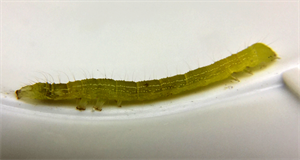- Worldwide distribution. Present in most Pacific island countries. Hosts are bele, cotton, okra, tomato, ornamentals and weeds (mostly Malvaceae).
- Damage: larvae eat leaves, buds, bolls (cotton), sometimes defoliating entire plant.
- Eggs laid singly; long green larvae, seven faint white lines (dots or broken lines) along body, and yellowish bands between segments. Only four pairs of prolegs. Adults have brown wings with gold patch near body.
- Natural enemies: tachinid flies, wasps, fungi; none reported from Pacific.
- Cultural control: avoid overlapping crops and new next to old; crop rotation (3 months); apply manures or fertilizers for healthy growth; handpicking; collect and burn debris after harvest.
- Chemical control: biorational pesticides: (i) botanicals (chillies, neem, derris, pyrethrum); (ii) microbials e.g., spinosad, Bt (Bacillus thuringiensis subspecies kurstaki) against young caterpillars; (iii) synthetic pyrethroids - avoid if possible as they are likely to destroy natural enemies, if present.





